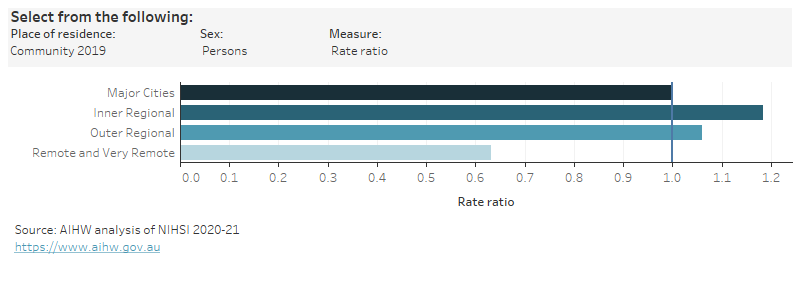Residential respite care use
This report explores the use of residential respite care among 2 groups of people living with dementia (see Methods section):
- “Community 2019” group: people living in the community in 2019, who did not enter permanent residential aged care in 2019 or 2020
- “Subsequent PRAC” group: people living in the community for all or some of 2019, who did enter permanent residential aged care later in 2019 or in 2020.
The use of residential respite care by people who did not enter permanent care in the subsequent 12 months was low overall (an average 5.4% of people). The highest rates were among people living in Inner regional areas (6.2%) and the lowest rates were in Remote and very remote areas (3.3%).
The use of residential respite care was more common for people who did enter permanent care in the subsequent 12 months (an average of 70% of people). There was no clear pattern of variation by remoteness area, with rates ranging from 66% in Remote and very remote areas to 72% in Outer regional areas.
For both groups, people who used residential respite care had an average of 1.5 stays per person (see Table S5.1 for details).
Figure 2.4: Residential respite care use among people in the dementia cohort, by place of residence, remoteness area and sex, 2019–2020
Figure 2.4 is an interactive bar chart showing variation in the use of residential respite care by remoteness area for people in the dementia study cohort who entered permanent residential aged care in the subsequent 12 months and those who did not. Measures of use are percentage of people with at least one stay, age-standardised rates, rate ratios and the average number of stays per person with at least one stay.

Notes
- The dementia study cohort refers to 158,730 people aged 30 and over who were living in Australia in 2019 and had a dementia record in the NIHSI. Western Australia and the Northern Territory were excluded from all analyses because their hospital data were not available for construction of the cohort.
- The geographies in this report are based on where a person lived, not where they received services. Remoteness areas are based on the 2016 Remoteness Area Structure within the ASGS.
- PRAC = permanent residential aged care
- ‘Percentage’ is the proportion of people in the dementia cohort with at least one service recorded in the NIHSI in 2019.
- Rate ratios are a method for comparing rates between regions. The rates for people living with dementia in Major cities were used as the reference population to compare with other remoteness areas. A rate ratio of 1 indicates that the rate for the region is the same as the rate in the reference population. A rate ratio greater than 1 indicates that the rate for the region is higher than the rate in the reference population. A rate ratio less than 1 indicates that the rate for the region is lower than the rate in the reference population.
- Age-standardised rates were calculated where population and service counts allowed.
- “Mean (service users)” is the mean number of attendances per person for people in the dementia cohort who used the service at least once in 2019.
- The bar is blank if a value could not be published due to data quality or confidentiality concerns.
Data tables: Residential respite care use among people in the dementia cohort


